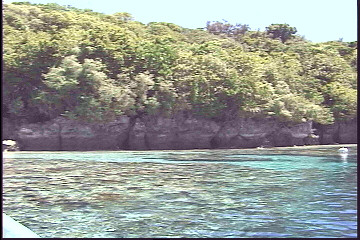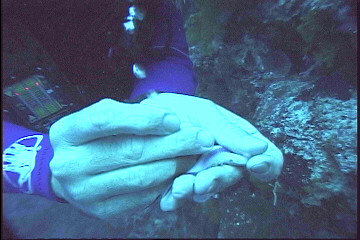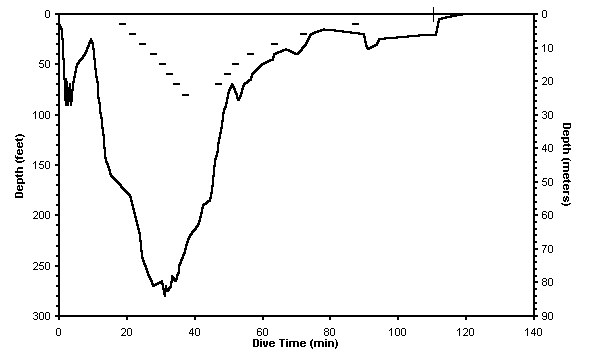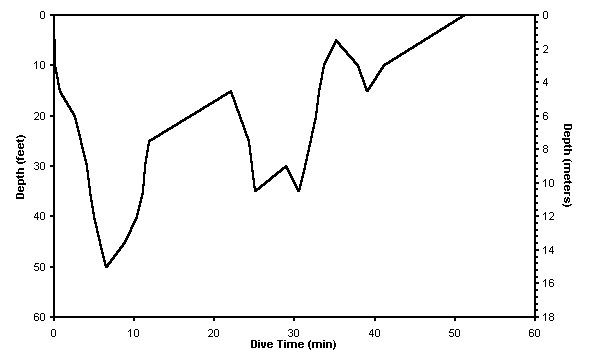Daily Log Report for
18
May 1997
Submitted by Richard Pyle
 The weather was
magnificent today; our last day of diving on this
expedition. John left us early this morning for his
return to Hawaii. The rest of us also started out
relatively early this morning, cruising at high speeds
over glassy water towards the south end of Palau. Shown
in the photo at right are the "Seventy Islands"
of Palau; a group of rock islands that are protected from
human disturbance by strict conservation laws. We passed
(at a distance) by these islands on our way from the
marine lab facilities in Koror, to the island of
Ngemelis, near the southern tip of Palau's main lagoon.
The weather was
magnificent today; our last day of diving on this
expedition. John left us early this morning for his
return to Hawaii. The rest of us also started out
relatively early this morning, cruising at high speeds
over glassy water towards the south end of Palau. Shown
in the photo at right are the "Seventy Islands"
of Palau; a group of rock islands that are protected from
human disturbance by strict conservation laws. We passed
(at a distance) by these islands on our way from the
marine lab facilities in Koror, to the island of
Ngemelis, near the southern tip of Palau's main lagoon. Our destination was a place
known to divers as "Big Drop". This is a
spectacular sheer vertical reef drop-off starting from
the surface, and continuing down in places more than
1,000 feet. At the particular spot we chose to make our
dive, the vertical wall bottoms-out at a depth of about
170 feet, then a sand and rubble slope continues down to
well-past 300 feet. Ken was originally going to join us
on this dive, but discovered a leak in his mouthpiece as
he was getting in the water, so he decided not to go
deep.
Our destination was a place
known to divers as "Big Drop". This is a
spectacular sheer vertical reef drop-off starting from
the surface, and continuing down in places more than
1,000 feet. At the particular spot we chose to make our
dive, the vertical wall bottoms-out at a depth of about
170 feet, then a sand and rubble slope continues down to
well-past 300 feet. Ken was originally going to join us
on this dive, but discovered a leak in his mouthpiece as
he was getting in the water, so he decided not to go
deep.
Pat and I descended together, then I saw some unusual fishes in a rubble patch at a depth of about 260-275 feet. I stopped and tried to collect some, while Pat continued further down the slope, along the face of a small rock "buttress" further down the slope. Among the fishes I collected was another female specimen of the angelfish, Genicanthus bellus. I also saw many individuals of the wrasse we are calling Cirrhilabrus sp. 1, but we have enough specimens of this new species already, so I didn't bother trying to collect any more of them.
 During the ascent, I
stopped to "decompress" the fish (as I have
been doing on almost every dive this expedition). Unlike
humans, who breathe compressed gas underwater, fishes
(which breathe water) do not suffer from decompression sickness
(the "bends") when brought directly to the
surface from great depth. However, most reef fishes
possess an organ called a "swimbladder", which
is analogous to a scuba diver's buoyancy compensator
device (BCD). Like the divers, these fishes expand or
compress their swimbladders to maintain neutral buoyancy.
However, if brought straight to the surface from great
depth, the swimbladder will expand in response to the
decreasing ambient pressure,
in some cases crushing the other vital organs of the
fish. To avoid this problem, I generally stop at some
depth during my ascent and insert a hypodermic needle
into the swimbladder, venting off the excess gas (see
photo above). When performed properly by trained
individuals, this procedure doesn't seem to harm the fish
any more that a person is harmed when receiving a shot
from a doctor. In most cases, the wound heals almost
instantly, and if the fish is kept in clean water, does
not develop any infections.
During the ascent, I
stopped to "decompress" the fish (as I have
been doing on almost every dive this expedition). Unlike
humans, who breathe compressed gas underwater, fishes
(which breathe water) do not suffer from decompression sickness
(the "bends") when brought directly to the
surface from great depth. However, most reef fishes
possess an organ called a "swimbladder", which
is analogous to a scuba diver's buoyancy compensator
device (BCD). Like the divers, these fishes expand or
compress their swimbladders to maintain neutral buoyancy.
However, if brought straight to the surface from great
depth, the swimbladder will expand in response to the
decreasing ambient pressure,
in some cases crushing the other vital organs of the
fish. To avoid this problem, I generally stop at some
depth during my ascent and insert a hypodermic needle
into the swimbladder, venting off the excess gas (see
photo above). When performed properly by trained
individuals, this procedure doesn't seem to harm the fish
any more that a person is harmed when receiving a shot
from a doctor. In most cases, the wound heals almost
instantly, and if the fish is kept in clean water, does
not develop any infections.
 After venting the
swimbladders of the fish I collected, I had an extremely
enjoyable decompression along the spectacular "Big
Drop" dive site. I was amazed by how
closely I could approach the schools of fusiliers (fishes
of the family Caesionidae - shown at right) with the
rebreather. Bubble-producing scuba divers often have
great difficulty getting close to these species
underwater. I also saw an assortment of jacks (species of
the family Carangidae) and a Napoleon wrasse (Cheilinus
undulatus), among other reef fishes.
After venting the
swimbladders of the fish I collected, I had an extremely
enjoyable decompression along the spectacular "Big
Drop" dive site. I was amazed by how
closely I could approach the schools of fusiliers (fishes
of the family Caesionidae - shown at right) with the
rebreather. Bubble-producing scuba divers often have
great difficulty getting close to these species
underwater. I also saw an assortment of jacks (species of
the family Carangidae) and a Napoleon wrasse (Cheilinus
undulatus), among other reef fishes.
After a very pleasant lunch near Ngemelis island, we went to a spot called "German Channel" by the dive operators; a place just outside the "real" German Channel (a small boat channel dredged by the Germans) where manta rays often congregate. I was not terribly interested in manta rays, so I decided to sit the dive out, while Ken and Pat did a short dive with the rebreathers, and the others used what was left in the remaining scuba tanks.
Tomorrow we leave Palau early in the morning, which means we will be up late tonight packing gear. The expedition is now definitely coming to a close, and I feel confident at this point deeming it a complete success.

